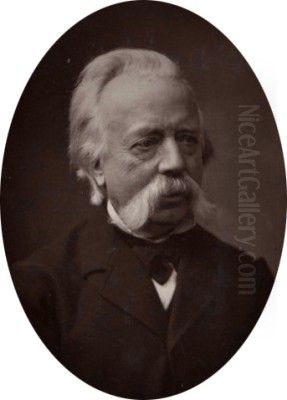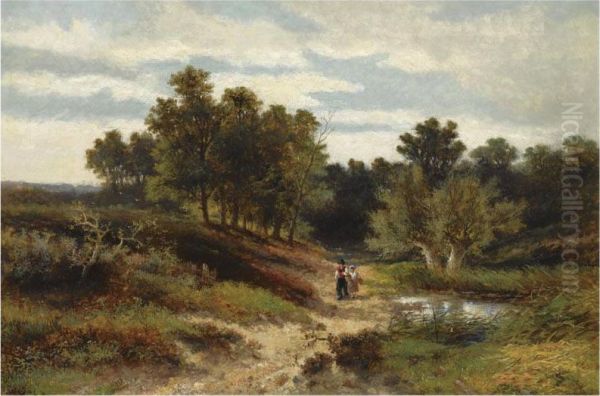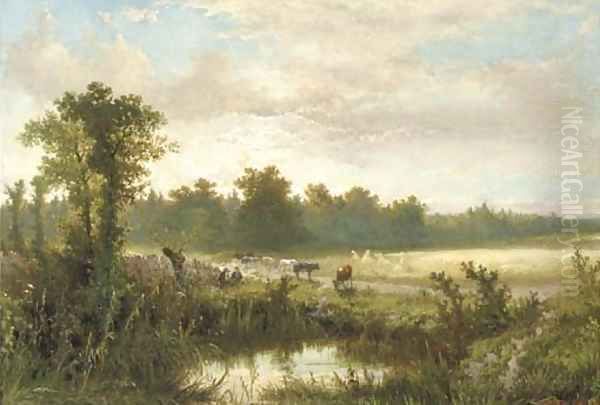
Johannes Warnardus Bilders stands as a significant figure in 19th-century Dutch art, a painter whose dedication to the natural world and mentorship of younger artists laid crucial groundwork for the emergence of the Hague School. His life and work represent a pivotal transition in Dutch landscape painting, moving from the lingering ideals of Romanticism towards a more direct, observational, and atmospheric Realism. Born in Utrecht and later making Oosterbeek his home and artistic haven, Bilders not only captured the serene beauty of the Dutch countryside but also fostered a community that would redefine its depiction.
Early Life and Artistic Beginnings
Johannes Warnardus Bilders was born on August 18, 1811, in Utrecht, Netherlands. Little is recorded about his earliest artistic training, but it is clear that he developed a passion for painting from a young age. The artistic environment in the Netherlands during his formative years was still feeling the echoes of its Golden Age, but contemporary art was searching for new directions. Romanticism, with its emphasis on idealized landscapes and dramatic emotion, was a prevailing influence across Europe, and Dutch artists were also exploring its tenets.
Bilders initially worked in the prevailing Romantic tradition, which often involved studio compositions based on sketches, sometimes imbuing landscapes with a sublime or picturesque quality. However, his deep connection to the Dutch countryside and a growing desire for more truthful representation began to steer his artistic compass. He was not formally a student of any single great master in the traditional sense but developed his skills through diligent practice, observation, and engagement with the artistic currents of his time. His early works, while competent, were yet to fully reveal the distinctive path he would later forge.
The Oosterbeek Years: A Dutch Barbizon

A defining moment in Bilders' career and in the trajectory of Dutch landscape painting came in 1841 when he moved to Oosterbeek. This picturesque village, located near Arnhem in the province of Gelderland, was renowned for its beautiful wooded landscapes, heathlands, and the nearby Rhine river. Oosterbeek, with its varied natural scenery, offered artists an abundance of motifs and an escape from urban life, much like the village of Barbizon near the Forest of Fontainebleau had for French painters.
In Oosterbeek, Bilders became a central figure, almost a patriarch, for a burgeoning community of artists. He was drawn to the area's tranquil beauty and found it an ideal setting for plein air (open-air) sketching and painting, a practice that was gaining traction as artists sought more direct engagement with nature. He encouraged younger painters to abandon the more formulaic approaches of studio-bound Romanticism and to instead immerse themselves in the direct study of their surroundings. His home became a meeting place, and his presence attracted a host of aspiring artists who were eager to learn from his experience and share in the camaraderie of this informal "Oosterbeek School."
The atmosphere in Oosterbeek was one of creative exchange and a shared reverence for nature. Artists would venture into the woods and fields, sketchbooks and easels in hand, seeking to capture the subtle nuances of light, atmosphere, and the specific character of the local terrain. This emphasis on direct observation and a more subdued, truthful depiction of the landscape marked a departure from the often more dramatic and idealized scenes of earlier Romantic painters like Barend Cornelis Koekkoek.
Artistic Style and Philosophy
Johannes Warnardus Bilders' artistic style evolved significantly throughout his career. While his early works showed Romantic leanings, his mature style is characterized by a more realistic and atmospheric approach to landscape. He was particularly adept at capturing the tranquil moods of the Dutch countryside, focusing on wooded scenes, quiet streams, and expansive heathlands under characteristic Dutch skies.
His philosophy centered on the importance of truth to nature. He urged his followers and colleagues to look closely at the world around them, to study the effects of light and shadow, the textures of bark and foliage, and the subtle shifts in color that defined different times of day and seasons. This was a departure from the more theatrical compositions of High Romanticism. Instead, Bilders sought a more intimate and personal connection with the landscape, emphasizing its inherent beauty without overt dramatization.

His palette tended towards earthy tones – greens, browns, and greys – reflecting the natural colors of the Gelderland region. He paid careful attention to the play of light, often depicting dappled sunlight filtering through trees or the soft, diffused light of an overcast day. While not as radical in their brushwork or color theory as the later Impressionists, Bilders and his Oosterbeek contemporaries were certainly moving towards a more immediate and less polished rendering of their subjects. His work often evokes a sense of peace and solitude, inviting the viewer to share in his appreciation for the unspoiled natural world.
Representative Works
While a comprehensive list of all his works is extensive, certain paintings are often cited as representative of his style and focus. Many of his most characteristic pieces are simply titled with their location, emphasizing his commitment to specific, observed places.
Works such as "Landscape near Oosterbeek" or "Forest View near Vorden" exemplify his love for the wooded interiors and the particular quality of light found in these settings. "Wolfheze" is another well-known subject he, and later his son Gerard, painted, capturing the ancient, gnarled oaks and atmospheric depth of this historic forest area. These paintings showcase his ability to render the textures of nature, the density of foliage, and the subtle interplay of light and shadow that creates a sense of depth and realism. His depictions of heathlands, often under broad, cloudy skies, also convey the unique character of the Dutch landscape.
His paintings are not typically grand, heroic vistas but rather more intimate scenes that draw the viewer into the quietude of nature. The human presence, if included, is usually small and integrated into the landscape, emphasizing nature's dominance. The overall effect is one of calm contemplation and a deep, abiding affection for the Dutch countryside. These works are housed in various Dutch museums, including the Rijksmuseum in Amsterdam, the Groninger Museum, and the Mauritshuis in The Hague, attesting to their enduring significance.
Influence on a Generation: The Oosterbeek Mentorship
Johannes Warnardus Bilders' most profound impact may lie not only in his own canvases but also in his role as an inspiration and mentor to a younger generation of artists who frequented Oosterbeek. He was not a formal teacher in an academic sense, but his example, encouragement, and the artistic environment he fostered were immensely influential.
Among the young painters who gathered around him in Oosterbeek were several who would become leading figures of the Hague School. These included:
Anton Mauve: Known for his gentle landscapes with sheep and cattle, Mauve spent time in Oosterbeek and was significantly influenced by the emphasis on direct observation and atmospheric rendering.
The Maris Brothers:
Jacob Maris: Became one of the most prominent figures of the Hague School, celebrated for his atmospheric townscapes and beach scenes.
Matthijs Maris: Developed a more mystical and poetic style, but his early engagement with nature was also shaped by the Oosterbeek ethos.
Willem Maris: Focused on landscapes with cattle and water, capturing the light and moisture of the Dutch polders.
Willem Roelofs: One of the pioneers of the new naturalism in Dutch painting, Roelofs was also associated with Oosterbeek and shared Bilders' commitment to plein air painting. He later also spent time in Barbizon, further strengthening the connection between Dutch and French landscape developments.
Paul Joseph Constantin Gabriël: Another key figure who would contribute to the Hague School, Gabriël was known for his luminous depictions of the Dutch polder landscape, often emphasizing the wide skies and watery terrain.
These artists, and others, found in Bilders a guiding spirit. He encouraged them to develop their own individual styles while adhering to the principle of truth to nature. The Oosterbeek period served as a crucial incubator for the ideas and approaches that would later coalesce into the Hague School. Bilders' emphasis on capturing the specific mood and atmosphere of the Dutch landscape, rather than generic or idealized scenery, became a hallmark of this subsequent movement.
The Hague School: Bilders' Enduring Legacy
The Hague School, which flourished roughly between 1860 and 1890, was a pivotal movement in Dutch art. It represented a definitive break from the academic and Romantic traditions, embracing a form of Realism that was deeply attuned to the Dutch landscape and its unique atmospheric conditions. The artists of the Hague School sought to capture the "grey light" of Holland, the subtle tones, and the everyday scenes of rural life and coastal areas.
While Johannes Warnardus Bilders is generally considered a forerunner or precursor to the Hague School rather than a core member (as its main flourishing occurred in his later years and was centered more in The Hague), his influence is undeniable. The principles he championed in Oosterbeek – direct observation of nature, plein air sketching, and a focus on atmosphere and local character – were fundamental to the Hague School's aesthetic.
The artists he mentored, such as Mauve, the Maris brothers, and Gabriël, went on to become central figures of this movement. They carried forward the lessons learned in Oosterbeek, applying them to a wider range of subjects and further developing the techniques for capturing the distinctive Dutch light and environment. Other prominent Hague School painters like Jozef Israëls (known for his depictions of peasant and fisherfolk life), Hendrik Willem Mesdag (famous for his seascapes, including the Panorama Mesdag), and Johannes Bosboom (renowned for his church interiors) also shared this commitment to realism and atmospheric effect, even if their primary subjects differed. The French Barbizon School, with artists like Jean-Baptiste-Camille Corot, Théodore Rousseau, and Jean-François Millet, had a parallel and sometimes direct influence on the Hague School painters, but the groundwork laid by figures like Bilders within the Netherlands was crucial for its indigenous development.
Gerard Bilders: A Son's Artistic Journey
Johannes Warnardus Bilders' artistic legacy was also continued through his son, Gerard Bilders (1838-1865). Gerard showed considerable artistic talent from a young age and naturally followed in his father's footsteps, becoming a landscape painter. He studied with his father in Oosterbeek and was deeply influenced by his approach to nature.
Gerard, however, had a tragically short life, dying of tuberculosis at the age of 26. Despite his brief career, he made a significant contribution to Dutch painting. He is often seen as one of the key transitional figures bridging the Oosterbeek sensibility and the full emergence of the Hague School. Gerard's letters and writings provide valuable insights into the artistic ideas of the time, and he is credited with coining the term "grey school" to describe the tonal qualities favored by his contemporaries, a precursor to the "Hague School" name.
Gerard's work, like his father's, focused on the Dutch landscape, particularly cattle in meadows and wooded scenes. He had a keen eye for atmospheric effects and a subtle, tonal palette. His early death was a great loss to Dutch art, but his work and ideas, nurtured under his father's guidance, played a role in shaping the direction of the Hague School. The relationship between Johannes Warnardus and Gerard Bilders highlights a familial continuity in artistic pursuit and a shared dedication to the evolving vision of Dutch landscape painting.
Later Years and Recognition
Johannes Warnardus Bilders continued to paint throughout his life, remaining dedicated to his beloved Dutch landscapes. He lived to see the Hague School reach its zenith, a movement that owed a considerable debt to his pioneering efforts in Oosterbeek. While perhaps not achieving the same level of international fame as some of the leading Hague School figures, his contribution was recognized within the Netherlands.
His works were exhibited, and he maintained a respected position within the Dutch art community. He passed away on October 29, 1890, in Oosterbeek, the village that had become synonymous with his artistic life and influence. His paintings continue to be appreciated for their sincere and atmospheric portrayal of the Dutch countryside and are held in important public collections, ensuring his place in the narrative of Dutch art history.
His influence extended beyond his direct mentorship. By championing a more direct and unpretentious approach to landscape painting, he helped shift the aesthetic sensibilities of his time. He demonstrated that the familiar, local scenery of the Netherlands, rendered with honesty and sensitivity, could be a profound source of artistic inspiration. This was a crucial step away from the more grandiose or exotic subjects often favored by earlier Romantic painters and paved the way for the intimate realism of the Hague School. Artists like George Hendrik Breitner, though more associated with Amsterdam Impressionism, and Isaac Israëls, son of Jozef, also benefited from the broader shift towards realism and contemporary subjects that Bilders helped initiate.
Conclusion: A Quiet Revolutionary
Johannes Warnardus Bilders was, in many ways, a quiet revolutionary. He did not seek to shock or provoke through radical manifestos, but through his steadfast dedication to painting nature as he saw and felt it, and by inspiring others to do the same, he played a crucial role in transforming Dutch landscape art in the 19th century. His move to Oosterbeek and the artistic community that formed around him there became a vital catalyst for change, fostering a new appreciation for plein air painting and a more intimate, atmospheric realism.
As a mentor and an elder statesman for a generation of artists who would go on to form the celebrated Hague School, Bilders' influence was profound and lasting. He helped to steer Dutch art away from the waning conventions of Romanticism and towards a style that was more deeply rooted in the observation of the native Dutch environment. His legacy lives on not only in his own serene and evocative landscapes but also in the rich body of work produced by the artists he inspired, ensuring his enduring importance in the story of Dutch art. His life and work remind us that significant artistic shifts often begin with a quiet, persistent return to the fundamentals of observation and a deep love for one's subject.